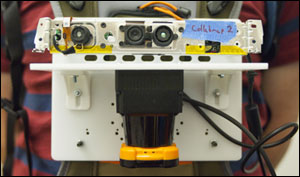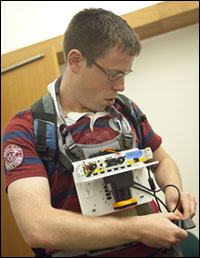
Wearable Sensor Maps Disaster Areas on the Fly
CAMBRIDGE, Mass., Sept. 26, 2012 — A wearable sensor system that includes a stripped-down gaming camera and a laser rangefinder could give emergency responders a boost by digitally mapping hazardous environments on the fly.
Developed at MIT, the device builds on previous research into systems that let robots map their environments. The machine’s sensors wirelessly relay data to an off-site computer, allowing observers to watch the map’s creation as the wearer maneuvers through a space — in this instance, the halls of an MIT building. The prototype, worn on the chest, includes a simplified Microsoft Kinect camera and a laser rangefinder.

The prototype sensor included a stripped-down Microsoft Kinect camera (top) and a laser rangefinder (bottom), which looks something like a camera lens seen side-on. (Images: Patrick Gillooly)
“The operational scenario that was envisioned for this was a hazmat situation where people are suited up with the full suit, and they go in and explore an environment,” said Maurice Fallon, a research scientist at MIT’s Computer Science and Artificial Intelligence Laboratory. "The current approach would be to textually summarize what they had seen afterward — 'I went into this room on the left, I saw this, I went into the next room,' and so on. We want to try to automate that."
Originally designed for robots, the system has been adapted for the complexities of human use. For example, the laser rangefinder, which provides accurate information about the distance of the nearest walls, is level on a robot but is jostled by a human in motion. In a robot’s wheels, sensors provide accurate information about physical orientation and distances covered, but that element is missing with humans. The system also must recognize changes in altitude when the wearer moves to a different floor.

Maurice Fallon, a research scientist in MIT’s Computer Science and Artificial Intelligence Laboratory, demonstrates how a user would wear the sensor.
Wearers can annotate the map using a handheld pushbutton attached to the sensor. In the prototype, it simply designates points of interest. The developers envision a future system that will add voice or text tags so emergency responders can mark structural damage or toxic spills.
The team also equipped the sensor with a cluster of accelerometers, gyroscopes and, in one group of experiments, a barometer.
"This idea of having a SLAM [simultaneous localization and mapping] system that is attached to a human's body, for figuring out where it is, is actually innovative and pretty useful," said Wolfram Burgard, a computer science professor at the University of Freiburg in Germany. "For first responders, a technology like this one might be highly relevant."
The work, supported by the US Air Force and the Office of Naval Research, will be presented in October at the Intelligent Robots and Systems conference in Portugal.
For more information, visit: www.mit.edu
Published: September 2012